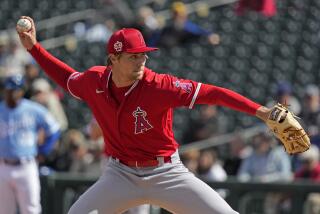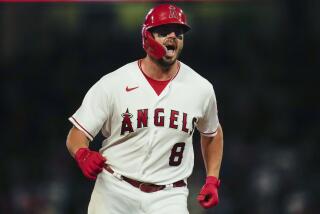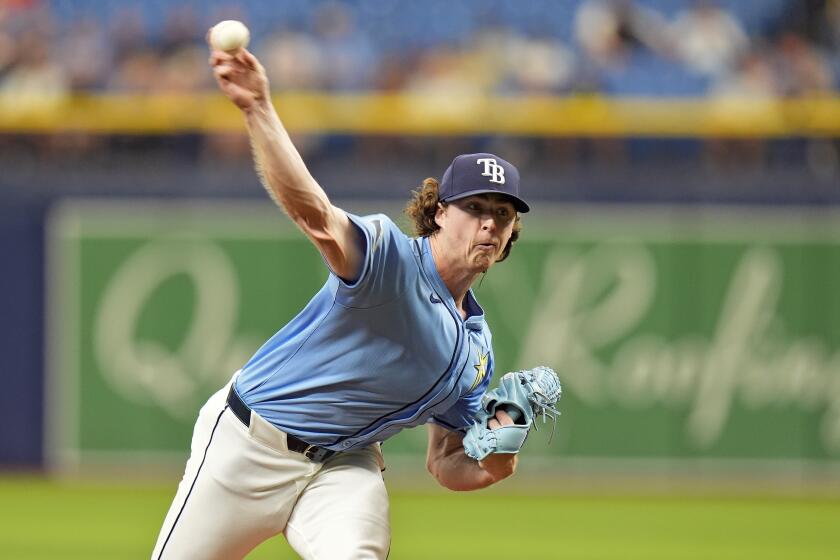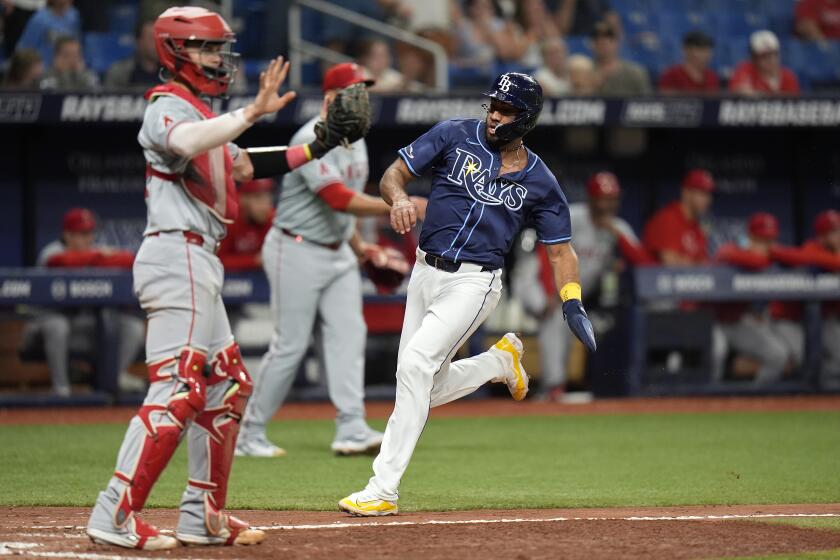PITCH MEETING
CLEVELAND -- To call Mark Teixeira’s plate appearance in the sixth inning of last Saturday’s game against the New York Yankees an at-bat wouldn’t do it justice.
It was more like an ambush.
In the first inning, Teixeira took the first two pitches from right-hander Dan Giese before striking out. He took the first pitch in the fourth for a ball before singling to right-center field.
The switch-hitter has such a reputation for taking pitches until he gets just the right one, that when Teixeira led off the sixth with the Angels trailing, 2-0, Giese just “wanted to get ahead with a fastball and expand the zone with my off-speed stuff,” he said.
Teixeira was lying in wait. He pulverized Giese’s first pitch, sending it halfway up the green tarp in right-center in Angel Stadium for a prodigious home run that jump-started the Angels in an eventual 11-4 victory.
Told two days later that it seemed he set up Giese for that at-bat, Teixeira chose to fess up rather than feign ignorance.
“Yeah, but don’t give away my secrets,” said Teixeira, who has brought a unique blend of power and patience to the middle of the Angels’ order since his July 29 trade from Atlanta.
“If I don’t know a pitcher, I’m not going to swing at the first pitch in the first couple at-bats so I can see what he’s going to throw me. Sometimes that does set him up for later in game.”
Patience, batting instructor Mickey Hatcher said, is the key.
“It’s frustrating for a pitcher who’s trying to paint the corners, and a guy is not swinging, and he’s getting ball one, ball two, ball three,” Hatcher said.
“So the pitcher says, ‘I’m going to throw this first one for a strike,’ and boom, home run. You have a better chance of doing that if you’re patient.”
Teixeira, 28, has had an immediate impact since being traded for Casey Kotchman, his addition thrusting the Angels from pennant contender to World Series favorite in the eyes of many.
Inserted into the third spot, Teixeira is batting .340 (17 for 50) with a .433 on-base percentage, four homers, 13 runs batted in, 12 runs, nine walks and six strikeouts in 13 games for the Angels, who play the Indians in Jacobs Field tonight.
He had a monster night Wednesday, crushing two home runs, including a game-tying shot in the ninth off closer J.J. Putz, in an eventual 12-inning loss to Seattle.
But as strong as the 6-foot-3, 225-pounder is, as lethal a bat as he wields, Teixeira can do considerable damage with that bat on his shoulder.
He learned as an All-American at Georgia Tech in 1999-2001 that he “wasn’t going to get pitched to a lot,” and he refined his approach under Texas hitting coach Rudy Jaramillo in his first five big league seasons, when he averaged 69 walks a year.
“If you take your walks and swing at strikes, then you have your base,” Teixeira said. “If you fish, if you swing at the pitcher’s pitch, then you really don’t have a plan, and you’re up there swinging at anything.”
In a combined 511 plate appearances for the Braves and Angels this season, Teixeira has seen 2,013 pitches, an average of 3.94 a plate appearance. Only 10 players in the American League have seen more pitches, and only one of them, Cleveland’s Grady Sizemore, had more homers than Teixeira.
Among Angels regulars, only Chone Figgins (4.09) averages more pitches per plate appearance. The averages for Teixeira’s new heart-of-the-order mates: Torii Hunter (3.56), Vladimir Guerrero (3.42), Garret Anderson (3.41).
Seeing more pitches, “You realize what a guy’s pitches are doing,” Teixeira said. “If you swing at the first pitch and ground out, the next at-bat, what have you learned from the first? You haven’t learned anything. So for me, swinging at my pitch gives me a better understanding of my strike zone.”
That doesn’t mean he always takes fat first-pitch fastballs. Just ask Giese.
“Being patient means I’m looking for my pitch on the first pitch,” Teixeira said. “If I get it right down the middle, I’m going to swing. But I try not to swing at a pitcher’s pitch early on.”
Such plate discipline is a much-welcomed addition to a lineup that features aggressive swingers such as Guerrero, Anderson, Hunter and Howie Kendrick.
“What makes him such a dynamic offensive player is he handles so many pitches in the zone, but he won’t expand the zone,” Manager Mike Scioscia said. “Rarely does he get himself out.”
Angels ace John Lackey is glad to have Teixeira on his side. With the Rangers, Teixeira hit .400 (18 for 45) with two home runs, 11 RBIs, six walks and three strikeouts against Lackey.
“He’s a power guy who doesn’t chase a lot,” Lackey said. “It’s fun to have him. We could use a guy who takes some pitches.”
That approach makes Teixeira, who has a .374 career on-base percentage and at least 26 homers each season, a perfect fit for the three hole.
Not only can Teixeira drive the ball to all fields from both sides of the plate, he gets on base for the big bats behind him, bringing even more depth to what has become the most potent lineup in franchise history.
“I’ve always heard Vladdy needs somebody to hit behind him to protect him, but if there’s nobody on base you can walk a guy,” Anderson said. “If guys are on base, they have to pitch to you.”
Anderson learned that years ago from former Angel Mo Vaughn.
“He always said having guys on was huge for guys in that part of the lineup,” Anderson said. “My average is higher with guys on base than with the bases empty, and to me it’s no coincidence.”
Indeed, Anderson is batting .371 with runners on base this season and .227 with none on. From 2005-2007, he hit .300 with runners on base and .274 with none on.
Guerrero is batting .305 with runners on and .283 with the bases empty. In the previous three years, Guerrero hit .343 with runners on and .307 with no one on.
Since Teixeira arrived, Guerrero is batting .360 (18 for 50) with five homers and 16 RBIs.
“Mark brings the added presence we need,” Anderson said. “Teams have to think different. It’s funny, but a name goes a long way in our business. They read the lineup and see it on paper and it’s like, ‘Oh, wow.’
“You can look at a different lineup that’s doing well and see different names and not be scared of them because you don’t know who they are and what goes along with those names.”
Teixeira hit third in Texas and fourth in Atlanta and can see the benefits to the current alignment.
“Every player is more dangerous when guys are on base,” he said. “The pressure is on the pitcher. If I’m on, Vlad will be more dangerous because his hits will drive in runs.”
The big question, though, is can the Angels keep this dynamic one-two punch together for more than three months?
Teixeira will be a free agent after the season and will command a huge contract in salary and years. He is represented by Scott Boras, who usually takes clients deep into the winter and gets them top dollar.
And, much like his approach at the plate, Teixeira won’t jump at the first big offer. He barely blinked in turning down $140 million from the Rangers before being traded to Atlanta last July. “It took me about 10 seconds to make that decision,” Teixeira said. “Losing gets old quick. In five years, we didn’t finish higher than third place. It was time for me to move on.”
With the perennial-contending, big-market Angels, Teixeira is on course to play in the postseason for the first time in his career, and he said the transition to his club has been “smooth, painless.”
But can he envision staying for a while?.
“I’ve always loved playing here, and Southern California is gorgeous,” said Teixeira, who recently settled into a Laguna Beach home. “But we’ll talk about those things at the end of the season.”
--
--
(BEGIN TEXT OF INFOBOX)
Mark Teixeira hit .283 with 20 home runs, 78 RBIs and 63 runs scored in
103 games with Atlanta this season. His numbers in 13 games with the Angels:
340
batting average
--
4
home runs
--
13
runs batted in
--
12
runs scored
More to Read
Go beyond the scoreboard
Get the latest on L.A.'s teams in the daily Sports Report newsletter.
You may occasionally receive promotional content from the Los Angeles Times.







